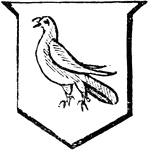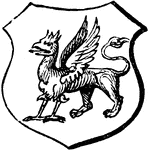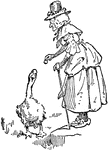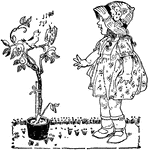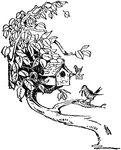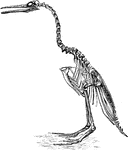
The Restoration of the Hesperornis Regalis
"Hesperornis regalis, (a fossilized restoration) which stood about three feet high, had blunt teeth…

Skeleton Head of a Ichthyornis
"Ichthyornis victor and I. dispar, ...were small forms of about the size of a Partridge, with the habits…

Martlet Difference
"Fourth Son, the MARTLET. The differences used by armorists at the present time are nine in number.…

Demi-Griffin Crest
"Crest, a demi-griffin armed, gules. ARMED. This word is used to express the horns, hoofs, beak, or…
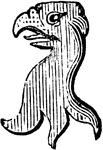
Eagle Beaked
"An eagle's head erased, beaked, or. BEAKED. The beak of a bird being of a different tint from the body…
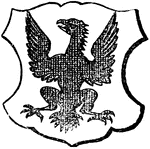
Eagle Displayed
"Argent, an eagle displayed sable. DISPLAYED. A bird whose wings are expanded and legs spread is said…

Dragon
"Argent, a dragon proper, tail nowed. DRAGON.. An imaginary monster; a mixture of beast, bird, and reptile.…

Bird Wing
There are two types of classification, homology and analogy. Homology is the fundamental identity of…
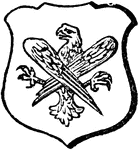
Eagle en Arrière
"Argent, an eagle proper en arrière. EN ARRIÈRE. An expression borrowed from the French,…
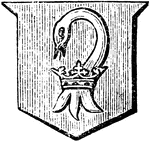
Swan Gorged
"A swan's head erased at the neck, ducally gorged or. GORGED. Any animals, particularly birds, that…
the Windpipe of a Male Red Breasted Merganser
"Trachea or windpipe of the red breasted merganser, Mergus serrator, about half natural size, viewed…
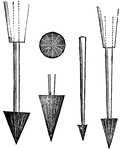
Egg Drills are Special Tools Used for Preparing and Blowing Eggs
"Figure 4 - egg-drills, different sizes. Steel implements with a sharp-pointed conical head of rasping…
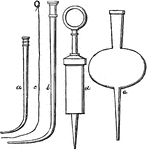
Several Special Instruments Used in the Process of Egg Blowing
"Figure 5-Instruments for blowing eggs; a,b, blow-pipes, 1/2 natural size; c, wire for cleansing them;…

Scissors, Knives, and Forceps Used for Egg Blowing
"Fig. 6- scissors, knives, and forceps, 1/2 natural size." Elliot Coues, 1884 These items may be used…

Hooks Used in the Process of Egg Blowing for the Purpose of Extracting Embryos
"Figure 7-hooks for extracting embryos, natural size; a,b,c, plain hooks; d, bill-hook, having cutting…
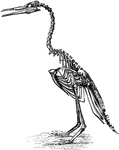
Restoration of Hesperornis regalis
"Hesperornis regalis, (a fossilized restoration) which stood about three feet high, had blunt teeth…
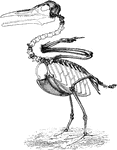
Restoration of Ichthyornis
"Ichthyornis, though the wings are well developed, with fused metacarpals, and the sternum is keeled,…
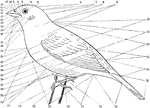
Topography of a Bird
"fig. 25 - Topography of a Bird. 1, forehead (frons). 2, lore. 3, circumocular region. 4, crown (vertex).…
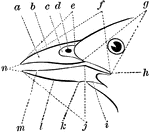
The Parts of a Bird Bill
"Fig. 26 - Parts of a Bill. a, side of upper mandible; b, culmen; c, nasal fossa; d, nostril; e(see…
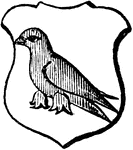
Martlet
"Argent, a martlet, gules. MARTLET. An imaginary bird said to be without legs; it is used both as a…

Mother Holding Child to Look at Bird in Cage
An illustration of a mother holding a child to look at a bird in a cage.
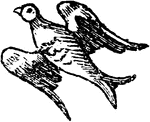
Bird Volant
"VOLANT. The French word for flying. It is used in Heraldry to express the same action." -Hall, 1862
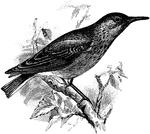
Common Miner
The Common Miner (Geositta cunicularia) is a passerine bird in the Furnariidae family of ovenbirds.
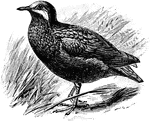
Olive-Backed Quail-Dove
The Olive-Backed Quail-Dove (Geotrygon veraguensis) is a bird in the Columbidae family of pigeons and…
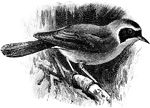
Common Yellowthroat
The Common Yellowthroat or Maryland Yellowthroat (Geothlypis trichas) is a bird in the Parulidae family…
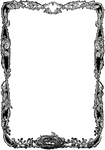
Raspberry & Vine Border
An illustration of a full page border with vines and raspberries on the bottom.
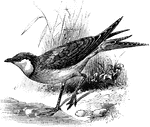
Collared Pratincole
"Common Glareole or Pratincole (Glareola pratincola). GLAREOLA. A remarkable genus of birds, typical…
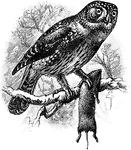
Northern Pygmy Owl
The Northern Pygmy-Owl (Glaucidium gnoma) is an owl in the Strigidae family of true owls.
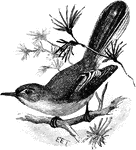
Blue-Gray Gnatcatcher
"Blue-gray Gnatcatcher (Poliptila caerulea). The blue-gray gnatcatcher, Polioptila caerulea, is a very…
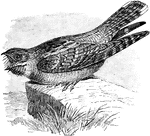
European Nightjar
The European Nightjar (Caprimulgus europaeus) is a bird in the Caprimulgidae family of nightjars.
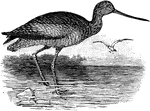
Marbled Godwit
The Marbled Godwit (Limosa fedoa) is a large shorebird in the Scolopacidae family of waders.
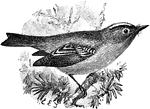
Goldcrest
The Goldcrest (Regulus regulus) is a small bird in the Regulidae family of kinglets. It was also known…

American Goldfinch
The American Goldfinch (Carduelis tristis) is a North American bird in the Fringillidae family of finches.

Goldfish
"Goldfish (Carassius auratus). A fish of the carp family Cyprinidae, Cyprinus or Carassius auratus,…
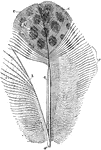
Feather from a Argus Pheasant
"Fig. 19 - A partly pennaceous, partly plumulaceous feather, from Argus pheasant; after Nitzsch. ad,…

Structure of a Feather
"Fig. - 20 - Two barbs, a, a, of a vane, bearing anterior, b, b, and posterior, c, barbules; enlarged;…
Single Barbule
"Fig. 21. -A single barbule, baring barbicels and hooklets; magnified; after Nitzsch. ...barbicels (another…

Barbs
"The arrangement shown in fig. 22, where a, a, a, a, are four barbs in transverse section, viewed from…
A Feather from the Tail of a Kingbird
"Fig. 23 - A feather from the tail of a kingbird, Tyrannus carolinensis, almost entirely pennaceous;…

Pterylosis of Cypselus Apus
"Fig. 24. - Pterylosis of Cyoselus apus, drawn by Coues after Nitzsch; right hand upper, left hand lower,…

The Bones of the Right Wing of a Duck
"Fig 27. - Bones of the right wing of a duck, Clangula islandica, A, shoulder, omos; B, elbow, ancon;…
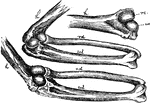
Mechanism of the Elbow-Joint
"Fig. 28. - Mechanism of elbow-joint. ..., where rc and uc show respectively the size, shape, and position…

The Wing Bones of a Young Grouse
"Fig. 29., from a young grouse (Centrocercus urophasianus, six months old), is designed to show the…
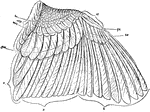
Feathers of a Sparrow's Wing
"Fig. 30., Feathers of a sparrow's wing. pc, covers of the primaries; msc, median upper secondary coverts;…
Red Shafted Woodpecker Ulna
"Fig. 31. - Ulna of Colaptes mexicanus, showing points of attachment of the secondaries. (Dr. R. W.…

Lyre-bird
"The Lyre-bird of Australia, Menura superba, to show the unique lyrate shape of the tail." "... the…
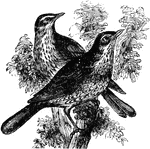
European Redwing
Two European Redwing birds sitting on a tree branch. These song birds are usually brown with darker…

Robin
"Robin: Upper parts slate-color, with a shade of olive. Head black, the eyelids and a spot before the…

Bird Skulls
"Fig. 114. -Skulls of Turdidae and Sylvicolidae, nat. size; after Shufeldt. A, Oroscoptes montanus;…

Wood Thrush
"Wood Thrush. Upper parts, including the surface of the closed wings, tawny-brown, purest and deepest…
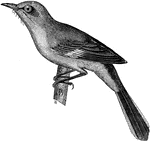
Mockingbird
"Mocking-Birds. Bill much shorter than head, scarcely curved as a whole, but with gently-curved commissure,…

Catbird
"Cat-Bird. Slate-gray, paler and more grayish-plumbeous below; crown of head, tail, bill, and feet black.…
Margin Drawing
This margin drawing was created by German artist Albrecht Dürer in 1515. It is found in the prayer…
Margin Drawing
This margin drawing was created by German artist Albrecht Dürer in 1515. It is found in the prayer…

Margin Drawing
This margin drawing was created by German artist Albrecht Dürer in 1515. It is found in the prayer…
